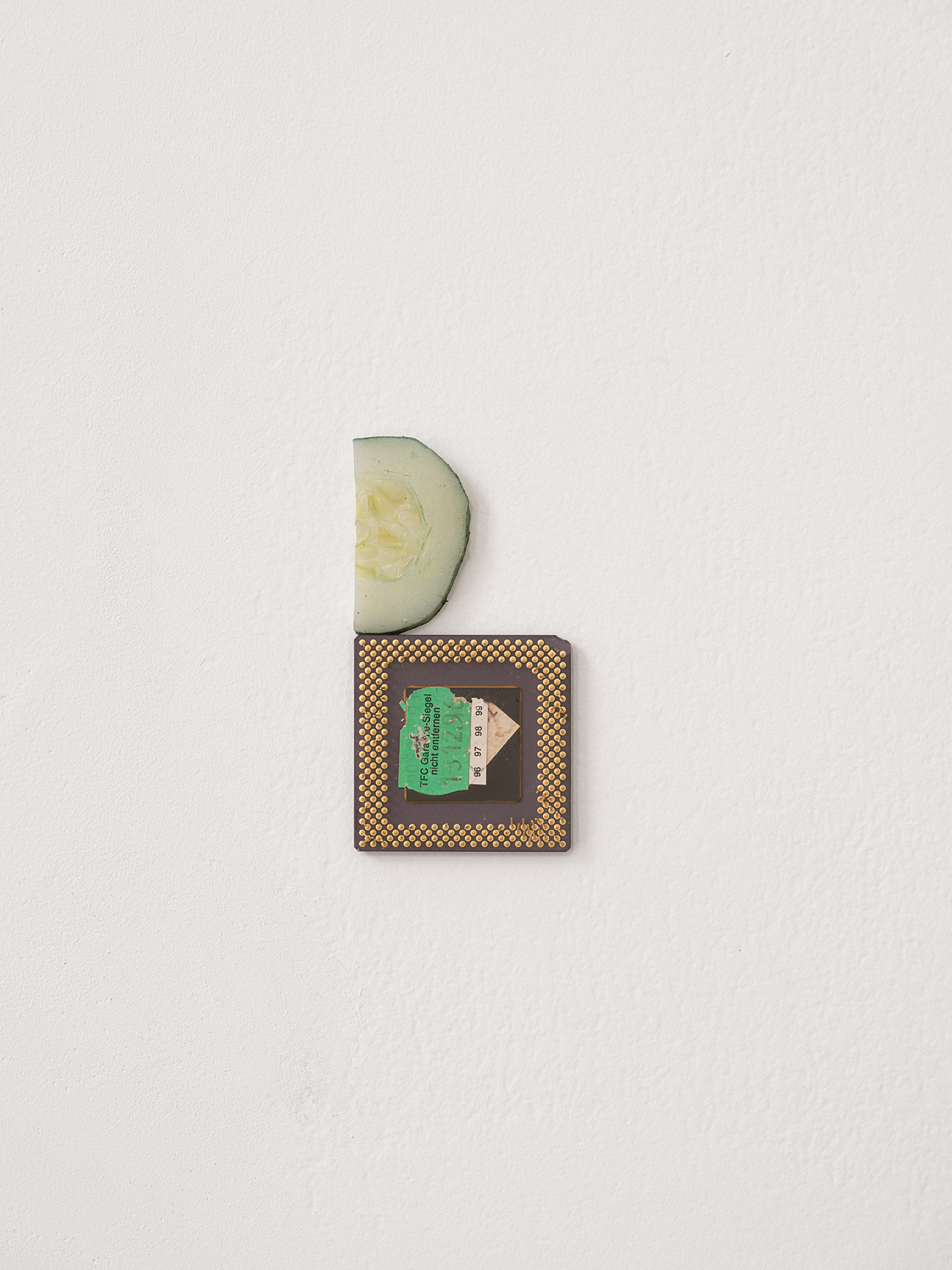Sunday Readings
Nina Canell: Memory-Shaped Gaps
Text by Martin Herbert published in Nina Canell's monograph
"Reflexologies", published by Sternberg Press, 2019
|
|
In its first active life, the object you're looking at lay on the cold ocean floor, maybe twenty kilometers down in the benthic zone where the lights are always out. Tasked with conveying tens of terabits of information per second, once it was part of something hundreds of miles long, its snaky black parent. Now it's a short chopped length, cross-sectioned so that its pragmatic constellation of interior wiring can be seen. Once its veins pulsed and thrummed, carried thousands of volts, and connected people in the lighted world above. Now, it's fiber-optic sushi.
We mostly consider electricity second nature and we don't tend to see undersea cable, partly because we're not down there and partly because it doesn't fit our technocratic metaphors. Our networked world, we like to think, operates through intangibles: clouds, information bouncing efficiently off the thousand or so satellites high over our heads. But satellite communications account for only about 1 percent of telecommunications worldwide. The rest takes place in liquid darkness, where it moves much faster, and is very physical. To go widescreen for a moment, undersea cables have been down there since 1842 and are inextricable from empire: Britain dominated the industry from the 1850s to 1911. Nowadays, every continent except Antarctica is cabled together, and each system costs hundreds of millions of dollars to construct. The cables, protected from human intervention by depth and confidentiality, nevertheless sometimes get chewed by sharks, and have a life expectancy of about twenty-five years. Yet we mostly don't know this, we don't see the cables and we don't think about them, just as we don't think about server farms and the energy consumed to maintain the internet or run Bitcoin, or the rare earths needed to make smartphones and how perilously they're harvested. If we think of them at all, if we even know, it's abstract and quickly pushed away in the screen's dazzle. But it's real, in the myriad miles of cabling and—to now go relatively tiny—at the sharp end of fibre-optic cables too, where information is converted into light and photons pass and jump from one section to the next, sometimes imperfectly. There are breaks, there are informational casualties, there is loss.
|
|
Nina Canell, The Nordic Pavilion, 57th Venice Biennale, Venice, 2017
|
|
To bring telecommunications cable, in stumped form, from the ocean floor to gallery floor is to engender something faintly paradoxical. It makes visible an intangible or perhaps brackets it for thinking about. Much of what might be considered to be in the work, when presented as sculpture, is actually outside it: the energetic legacy of data conveyance through this strange and unlovely thing. Cables, of course, don't have a lock on this sense of fulsome absence, goneness. When my grandmother was in her final years I repeatedly thought about recording her reminiscences—she'd led an unusual and interesting life—but I never did it, she never wrote anything down, and all that information vanished with her. My father died before I could think about doing anything similar, and his body was what corpses are: not the person, not their mind, their bodied life. The mere body, absent the will-o'-the-wisp, stands in for a slice of time between a birth and a death, and all that owed through them in that period. A cable stump is something like that. It points to what went through it, its raison d'être. If the category of sculpture is open to betweenness, that space is where these works live.
That space, indeed, is where Nina Canell's works generally live and live they do even when still. They are a somewhere in which a transferral happens, often unstably, responsive to bodies, movement, ambient temperature, energy per se. The cable stumps, the “cuts,” are outliers here in that they respond more to the fluctuations of the mind. We can talk about this in relation to sculpture itself: we can say Canell is conversing with a medium that has traditionally been static, gifting it with other and more fluid registers. What other components of sculpture are there—how about the air in the room, bodies in the room, static charges, sound, moisture, temperature, time? Yet while this analysis isn't outright wrong, it sets up Canell's work as a mere formalist expansion, and that's too limited a read.
As limited, in fact, as the one above, that would have her cables as merely evocations of the hidden face of computerization, transforming our planet while we, seduced by Silicon Valley's blandishments, blithely look the other way. Nor are they reducible to artifacts rejecting the shadow economies around cable waste disposal: the raw endpoints of these things once they break and get pulled out of the sea, dumped on the outskirts of, say, Seoul, possibly for an artist to nd, or to be strip-mined or destroyed. Again, such a take is not wholly wrong—good art is never one-sided—just not the whole.
|
|
Nina Canell, Reflexologies, Kunstmuseum St. Gallen, St. Gallen, 2018
|
|
The cables have forgotten, but it's in their blatant forgetting that they speak of memory: they create, pointedly, a memory- shaped gap, a want. They inhabit the space between memory and forgetting, whatever that would be called. Sometimes they are shown, in Canell's exhibitions, in proximity to wires that do remember, offering the speculative possibility that deep in these cuts, on some subatomic level, is the involuntary trace of what passed through them. A strange thing to even consider. We might do it, though, to make a further jump between the inanimate and the human, because Canell's art often comes back to the human. In a book produced for an earlier exhibition of hers, there is an appendix of notes: bits of philosophy, Shakespeare, Wikipedia, White House memoranda on energy meetings (“Basically, nothing happened”), and brainstorming between Canell and her collaborator, Robin Watkins. In one of the latter notes, she writes, “Cable stumps are cross-sections of a vocabulary of interruptions. A cut-off form. Ending mid-sentence.” Another text fragment brings up Gilles Deleuze and Felix Guattari's conception of the rhizome. A rhizome has neither a beginning or an end but always a middle, they note (what is a cable stump but a middle?).
If we read these and then we read something about subsea cables—e.g.,“One cable is worth more than twelve peace conferences,” from an issue of Popular History—interpretation bifurcates. Our mental image of the cables, down there, is likely to feel somewhat rhizomatic, a decentred and non-hierarchical network (leaving ownership aside), but our sense of what the rhizome is, or can be, might also turn more human. It's human connections, something that the physical rhizome of telecommunications technology facilitates but that technology also undoes (no need to talk too much here about how the internet has allowed us to talk to more people than we might have believed possible and also to be colder and uglier to them). What, then, might a rhizome full of interruptions look like? Something with a lot of spaces in it, spaces equating to potential, like two people trying to communicate in pidgin language. Conveyance has to leap across a gap and the gap is undefined—the gap as undefined being, again, a leitmotif in Canell's art. Think again of information, like photons, jumping across gaps in the cable, not always perfectly nor predictably—“coupling loss” is the operative phrase—and now ratchet that up to human exchange, human connection.
None of this is visible in the art. Canell shows these cuts, among many other things, and she reproduces diagrammatic cross-sections of different kinds of cable—signal, communications, power, data system—that look instructional, seemingly pointing to some process outside themselves, outside the work. They also resemble mandalas, as if the whole of reality were somehow contained in these concentric and clustered circlets. These, and the material objects she deploys, we might say, frame something but they do not depict it. This, I think, is because to depict certain things is to reduce them, specifically to reduce them to one person's idea of them. A statement rather than, more accurately, a conversation.
|
|
Nina Canell, Energy Budget, S.M.A.K (City Museum for Contemporary Art), Ghent, 2018
|
|
In the gallery, you in your body look at a cut cable, something that points to something outside of it: namely this complex of thematics and the kinaesthetic appeals we've already sketched that sits between forgetfulness and memory, live and dead, the theoretic conditions of the sculptural and the worldly conditions of our wired culture, the node and the rhizome. The very betweenness that is figured on a case-by-case basis here also applies to how the work ickers between all these poles of meaning. Sinking right down to the basic, benthic, basement level, it's you doing the interpretative work—sometimes refusing some kind of reading as too narrow—in search of a take, finally coming back to how fundamentally liminal it is, across all vectors. You're pulsing, looking at something that used to pulse; you may feel this in your gut. You're moving packets of information around, looking at a place where packets of information used to move around. And, who knows, if this pruned span were reconnected, might do again. It has that potential.
So pulse, and here is where the formalist gaming and the human aspect tie-up. In the gallery, Canell essays sculpture becoming something else. Fundamentally it is becoming energetic, energized, an unpredictable system of relays, exchanges, transfers, interfaces, one thing touching another, an old order gone. Something turning into something else scans on a social, society-wide level, and the way it happens is through things touching, communicating with each other. In the gallery, there's an invisible energy gathering, that of interpretation—a reckoning with doubt, since Canell's work, particularly the cuts, has a silence about it that asks to be contended with. It's you meeting it, a gap you have to leap across. In leaping, you might ask: What does, what can, connection mean, today and tomorrow?
“I'm interested in how the transformation of physical relations into dematerialized signals of exchange might preempt an even more immaterial (and less obviously communicational) form of non-verbal, perhaps telepathic, energy exchange.”
– In a 2016 interview, Canell notes.
|
|
Whatever the nature of the network, its essence is in what Canell points to by cross-sectioning cable. That there are points, physical ones even if miniscule, where content is unpredictably modi ed, like a game of Chinese whispers, and those points are scalable. Her entire art might thus represent one point of inter- face and you, the viewer, another. Then—expand—there's the you that turns to your companion in the gallery and says what you think it means, and they say what they think it means, and they talk to a third person later, and so on. Then—keep going— there's the whole of humanity doing that, constantly, using means that themselves are shifting and slipping and modifying us as a species. Human connection is human nature, and we keep finding new ways to do it, and its imperfection is an engine. And you can see the world as it is in that endless round of invisible ener- getic exchange; you can see transformative human potential; you can see a chronicle of inevitable change, for better or worse. It all depends on how, attended by chance, the interfacing occurs in you—what specific light leaps across the gap.
|
|
Nina Canell, Polyethylene-Insulated Smear, Mendes Wood DM, São Paulo, 2017
|
|
|
|













Comentários
Postar um comentário